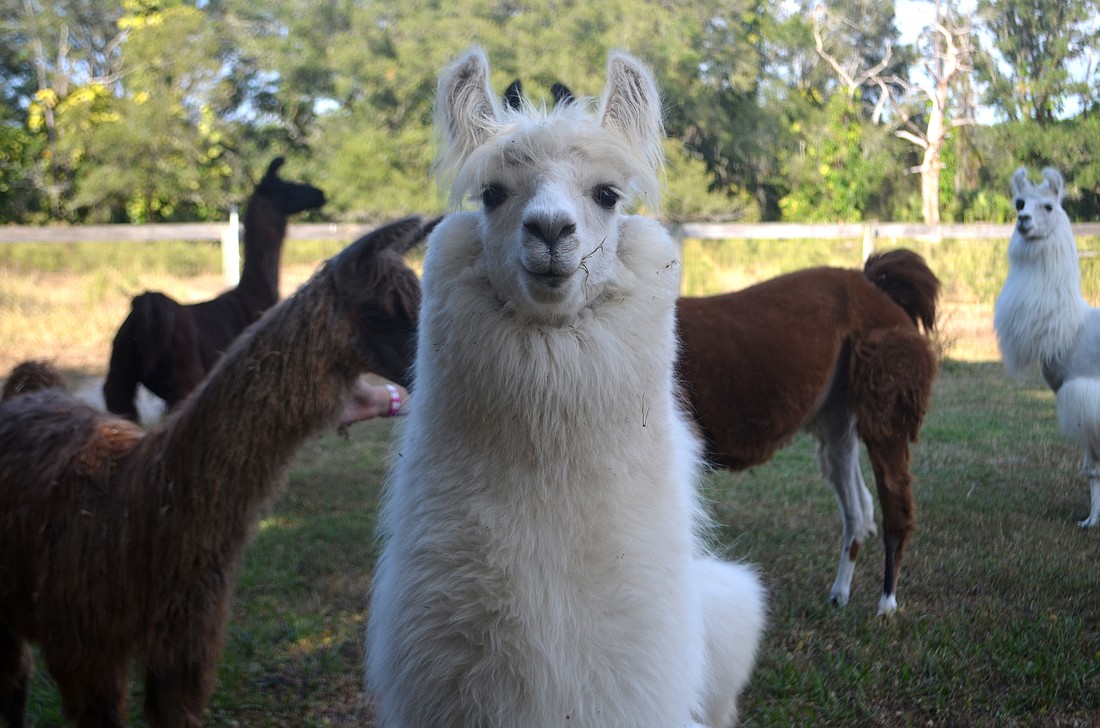- April 18, 2024
-
-
Loading

Loading

There are dog people, and there are cat people. Then there are people like Sarasota resident Kathy Wilbanks — llama people.
She has 12 of the large, camel-like creatures on her Oak Rest Llama Farm east of Interstate 75. They’re tall, some standing almost 6 feet, and a little awkward looking, with large, unblinking eyes and a perpetual grin because of their buck teeth.
“These are my dogs,” Wilbanks said. “They are my giant poodles.”
But these aren’t your average llamas. They don’t haul things, and they certainly don’t spit. In fact, these llamas prefer to cuddle.
Wilbanks has been registering her llamas as emotional support animals for more than 10 years. She takes them to nursing homes, hospitals, college campuses and just about anywhere people might need a little llama love.
She was introduced to pet therapy about 20 years ago when her mother was in a nursing home. Wilbanks and her two daughters would bring their rabbits and guinea pigs to visit. While Wilbanks spent time with her mom, her daughters would take their pets to visit other patients. Two years later, after her mother died, her youngest daughter expressed interest in showing llamas in livestock competitions.
Wilbanks fell in love.
She’s been working with a pet-therapy organization called Project PUP for about four years.
Project PUP board member Ellen Leber said all animals must complete a series of assessments to be certified by the organization.
They must demonstrate good leash behavior, the ability to remain calm around medical equipment and be patient as people pet them. She said she has helped register many dogs, but Wilbanks’ llamas were a first.
Right now she has four llamas registered with Project PUP — Goldrush, Pete, Rudy and Dipity — but the number of llamas Wilbanks registers varies.
She looks for what she calls the “old souls” in the herd. They’re usually quiet, stoic and observant.
“You have to get to know the babies and see which ones are very calm,” Wilbanks said.
Calm is key because Wilbanks’ llamas understandably tend to attract a crowd.
Their heads swaying as they meander into community centers and nursing homes, they are always welcomed with outstretched hands as patients hug their long necks.
Getting to and from events can be difficult as people approach Wilbanks and ask to pet her llamas in parking lots. Children pull up grass to feed to them as their parents take pictures. All the while the llamas stand still, unfazed.
Although llamas are often stereotyped as stubborn pack animals, Wilbanks said her emotional support llamas are natural nurturers.
“They know who needs more attention, and they’ll go find them,” Wilbanks said. “They’ll put their heads down on them and give them kisses. They bring a lot of joy.”
Wilbanks likes to say you get out of llamas what you put into them. Compassionate owners breed compassionate llamas.
Her llamas serve about 20 local organizations from nursing homes to nonprofits. She even lets local Future Farmers of America and 4H clubs use the llamas to show at livestock competitions. It’s a lot of work, but Wilbanks said it’s worth it when she sees people bond with her animals.
She remembers bringing Pete to an area nursing home. As Wilbanks was chatting with the supervisor, Pete lay down at the feet of one of the residents.
“You’re so beautiful. I love you. You could come home with me,” Wilbanks remembers the resident saying as she stroked Pete. The supervisor was shocked. The resident was suffering from severe Alzheimer’s and had not spoken for more than a year.
“We’ve been back three or four times,” Wilbanks said. “She doesn’t come out of her room very often, but for the llamas she comes down.”
It’s moments like that that keep Wilbanks motivated.
“When I’m 80, I’ll still have a llama,” she said.